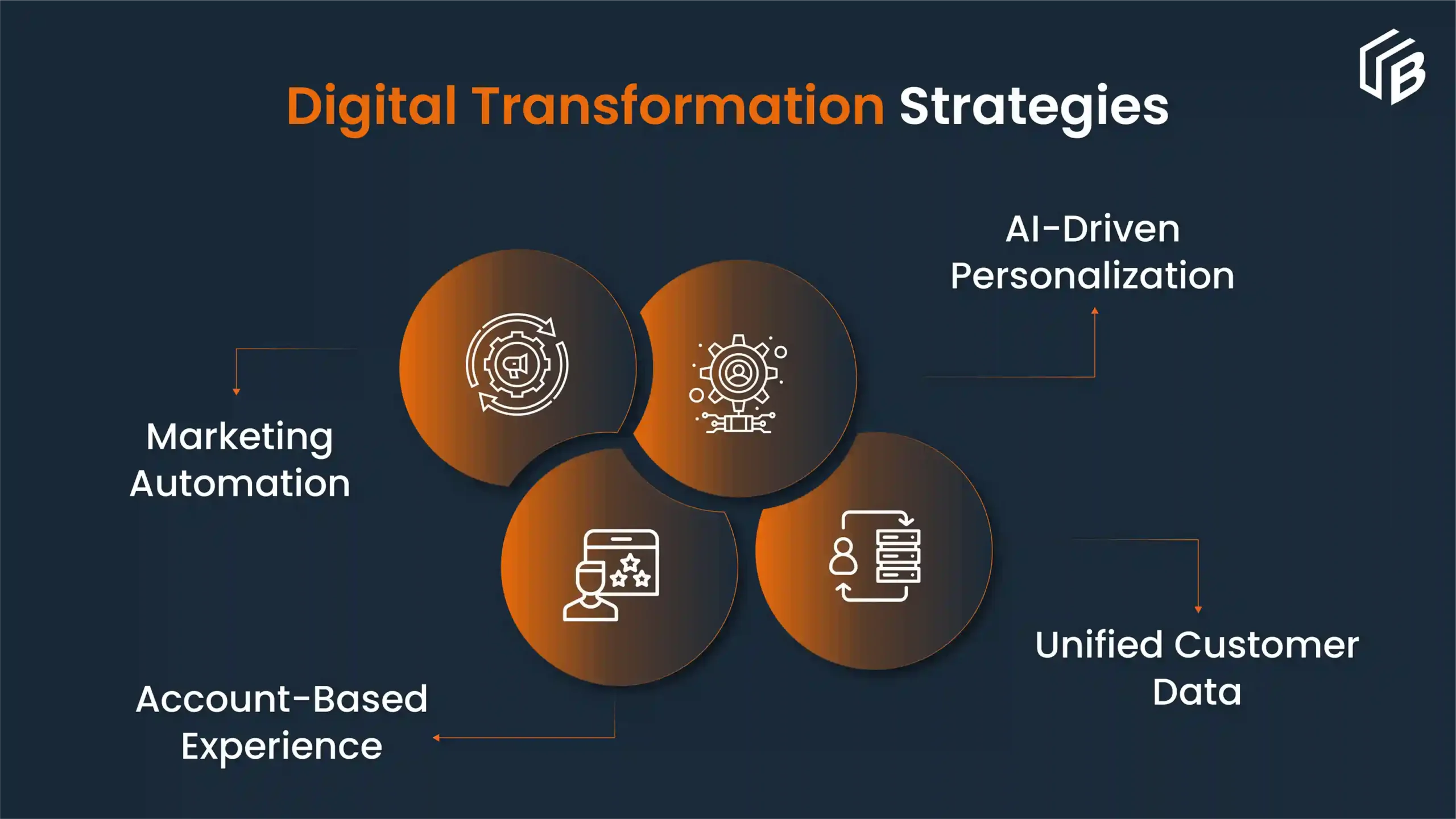Introduction
During economic uncertainties, marketing budgets are scrutinized, and efficiency becomes vital. Digital transformation is not just an option, it’s a competitive necessity. Companies that invest strategically in digital marketing now will also reap long-term success.
Under economic pressure, you and your board are forced to reassess your priorities and timelines. There’s no time or money to waste.
Digital marketing transformation improves your efficiency and helps to drive revenue – now and over time.
Specifically, digital marketing helps you optimize your spend, expand your audience reach, and even personalize your engagement with prospects and customers.
Harvard Business Review found that companies that invest in digital marketing transformation during downturns often emerge stronger when the economy recovers.
You can help your company do that, too. We suggest four important digital marketing strategies to evaluate for your digital transformation.
Strategy 1: Marketing Automation
Finetune your costs while you increase impact. That’s
marketing automation. It streamlines your operations so your teams can do more with less. Reduces manual tasks so they can focus on strategies and insights. Refine your marketing spend so you can build more customer touchpoints more effectively with every dollar.
Together with long-established technologies, AI is now an important strength within digital marketing. It improves your lead nurturing and expands the impact of your budget and your team’s leverage.
For example, Forrester Consulting studied companies that used Adobe’s integration of AI in Adobe Experience Cloud to personalize marketing at scale. Forrester calculated a return on investment of 333% and increased performance efficiency by 40%.
Do This Now
Evaluate marketing automation platforms such as HubSpot, Marketo, and Pardot to streamline your
lead scoring, nurture campaigns, and predictive analytics.
Strategy 2: AI-Driven Personalization
Increase your customer engagement with
AI-powered messaging. In economic downturns, precise and focused messages are the key to success. Your customers don’t have time or inclination for useless information. And you don’t have the budget to waste on it.
Hyper-relevant messaging, powered by your well-trained AI, helps you tailor your content to your customers’ interests and intentions. The reward is higher engagement, better conversion rates, and increases in revenues.
Let’s look at Salesforce, who embedded AI-powered personalization into its Einstein CRM platform. The outcomes? A top retail chain used personalized promotions and saw a
20% increase in sales. A financial services firm reduced customer churn by 15% and increased its retention rates as a result. The same effects are now possible in your B2B industry.
Do This Now
Select and implement content recommendation engines that use AI, such as Dynamic Yield, Persado, and Optimizely, to improve website engagement and email results.
Strategy 3: Account-Based Experience
Account-based marketing (ABM) has long been a cornerstone of
B2B demand generation, centered on targeted outreach to key accounts. However, traditional ABM often overlooked the critical factor of buyer readiness.
Account-based experience (ABX) fundamentally shifts this paradigm by focusing on the entire customer lifecycle and integrating marketing, sales, and customer success to create end-to-end experiences for accounts.
By prioritizing a customer-centric approach across the entire buyer journey, ABX ensures engagement is both timely and relevant. Applying data-driven insights from comprehensive market research, ABX empowers technology marketers to pinpoint the optimal moments and strategies for more meaningful account interactions.
Do This Now
Strategy 4: Unified Customer Data
Fragmented customer data spread across silos within your marketing technology stack wastes your team’s time and hides valuable insights. Consider a
customer data platform (CDP) to centralize your customer insights and fuel precise targeting and personalization. Without a single, valid view you can’t create consistent and compelling customer experiences across their touchpoints with your brand.
McKinsey found that one company used data from their CDP to understand influences across their customers’ journeys. By coordinating messages across their touchpoints, they found a 10-20% increase in conversion rates and customer lifetime value.
A major telecommunications provider used a CDP to connect more than 40 data sources to create a single view of its customers. Their marketing team used this innovation to build a hyper-targeted campaign in days, successfully increasing the number of successful opportunities by 20%.
Do This Now
Consider building your own customer data platform, such as Segment, BlueConic, and Tealium for a single source of truth for your marketing and sales data that gives you holistic customer insights.
Adapt and Adopt Digital Marketing Strategies During Recessions
Economic slowdowns are a unique opportunity for your business to accelerate digital transformation and enhance digital marketing. By shifting to digital technologies you can optimize operations, reach wider audiences, and
improve marketing efficiency.
AI-driven marketing automation helps you shift from reactive to predictive engagement, ensuring real-time personalization at scale. That’s critical for customer retention in volatile markets. Embracing strategic digital marketing means you can remain competitive and agile during a downturn.
Executives who embrace digital marketing transformation today will not only navigate current economic uncertainty but will also create a resilient, data-driven marketing organization ready for the next era of growth. Now is the time to lead that transformation to a digital-first world.












